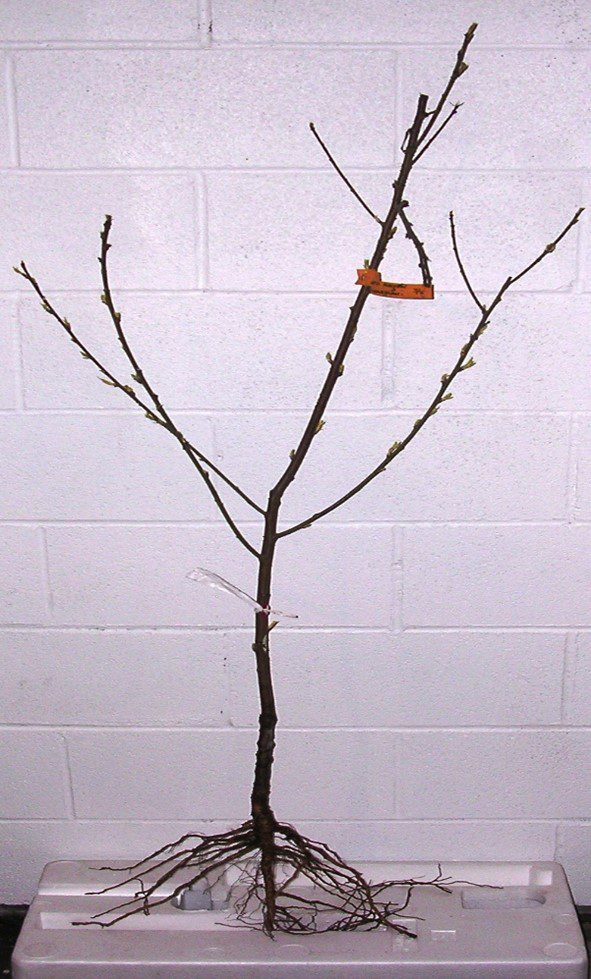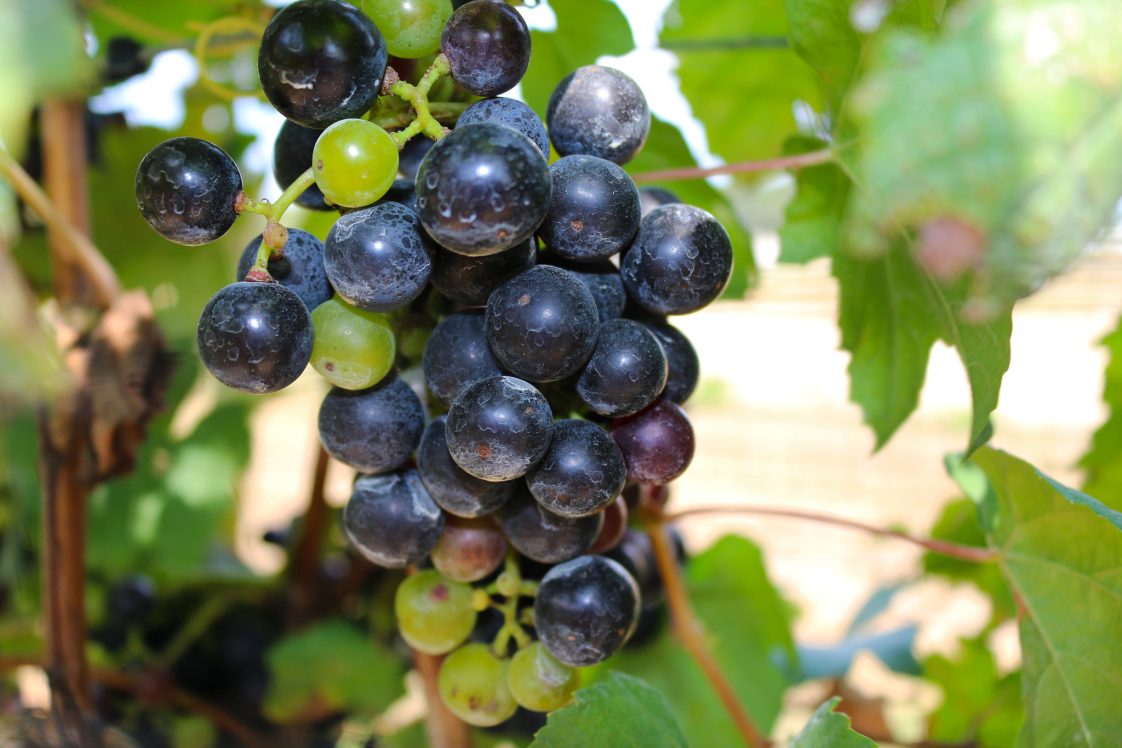Crop Production

Learn the various uses for rootstocks and how to choose the right ones for your growing needs.

Figure 1. Well-developed 21⁄2- to 4-foot peach trees are recommended for planting. (Photo credit: Greg Reighard, Clemson University)
All tree fruits, including citrus, are propagated onto the root system of another plant. This root system is commonly referred to as the understock or rootstock. The upper part of the grafted or budded plant that bears fruit is referred to as the scion variety.
Rootstock varieties are not as plentiful as scion varieties, so selecting the proper rootstocks to use with fruit types grown in a particular area is easier. However, growers should become familiar with the rootstocks of choice for their particular needs.
Rootstocks are used for a number of reasons:
- Rootstocks allow the easy propagation of trees of the same variety. Most tree fruits do not come true-to- type from seed.
- Rootstocks allow faster fruiting. Fruit trees grown from seed require 3 to 8 years to begin bearing.
- Rootstocks influence cold hardiness, overall fruit quality, yields, and disease and insect resistance.
- Rootstocks help control tree size (dwarf, semi- dwarf, or normal).
A number of highly efficient dwarfing rootstocks available are for apples. Except for apples, the home gardener often purchases tree fruits on standard rootstocks. If a tree on a dwarfing rootstock cannot be found, a home gardener may control tree size through judicious pruning and balanced fertilization. Dwarfing rootstocks for other tree fruits are still being researched. Not all retail outlets can verify rootstocks used. Use a reputable nursery that can supply the desired scion varieties and rootstocks.
Table 1 provides information to help producers select varieties of fruit crops on appropriate rootstocks. If a fruit crop is not listed, graftage is not the primary method of propagation, and rootstocks are not necessary. Most small fruit crops—blueberry, blackberry, strawberry—are propagated on their own roots without using rootstocks. Muscadine grapes are the exception.
Table 1. Rootstocks Recommended for Fruit Crops Grown in Alabama
| Fruit Crop | Rootstock | Description |
|---|---|---|
| Apple, Full Size, Vigorous | Seedling apple | Do not plant trees on this rootstock. |
| Apple, Semidwarf | G.30, G.969, G.935, G,202 | Geneva (G.) series of rootstocks are fire blight resistant and semidwarf—51% to 90% the size of seedling rootstock and similar in vigor to MM106. |
| Apple, Dwarf | G.11, G.41, G.935 | Use fire blight resistant dwarf rootstock from the Geneva (G.) series that are 30% to 50% the size of a seedling rootstock. Trees planted using these rootstocks are not freestanding and must be trellised or otherwise supported. |
| Pears, Common, European, and Asian Pears | Calleryana pear and fire blight resistant Old Home x Farmingdale series of rootstocks | Calleryana pear, (Pyrus calleryana), is the preferred rootstock for pears and Asian pears. Both types of pears are also propagated onto Betulaefolia (Pyrus betulifolia), but tend to be more susceptible to fire blight on this rootstock. |
| Peach, Nectarine, and Plum | Guardian, Lovell, MP-29, Nemaguard, Nemared | Guardian is the preferred rootstock across the state. Lovell is also very acceptable. Nemaguard is only suggested for south Alabama on sites where peaches and other stone fruits have not been grown. Nemared is similar to Nemaguard in performance but has not been used much in the southeast. Guardian is tolerant to peach tree short life. MP-29 is a semi- dwarf rootstock resistant to peach tree short life and Armillaria root rot. Supply of trees on MP-29 is limited at this time. Halford rootstock is still in use and is very vigorous. |
| Quince | Angers quince (Brossier series), QBA 29 | All varieties of quince are usually propagated on Angers rootstock. Most varieties can also be propagated by cuttings. |
| Plum, European Peach (Prune Type) | Lovell peach and Myrobalan plum | Lovell peach is preferred, but both rootstocks are acceptable. Other peach rootstocks listed above are also satisfactory. |
| Cherry, Sweet and Sour1 | Mahaleb and Mazzard cherry | Mahaleb is preferred. Some promising rootstocks are (dwarf) Gisela 3 and (semidwarf) Gisela 5, Gisela 6, Krymsk 5, and Krymsk 6. |
| Asian Persimmon | Lotus, Diospyros lotus, and native American persimmon, D. virginiana. | Asian (Japanese) persimmon (Diospyros kaki) performs well on both rootstocks. Most grafted trees bought from nurseries are on Lotus, especially if the trees are from California, but sometimes grafted trees are on Kaki. |
| Pomegranate | Graftage is not practiced; no rootstocks are used. | The easiest and best method of propagating pomegranates is by hardwood cuttings taken in the winter from the previous season’s growth. Plants can be grown from softwood cuttings placed in greenhouses, but this method is seldom used. |
| Muscadine Grape | Graftage is not practiced; no rootstocks are used. | Muscadines are most commonly propagated from mound layerage of new canes and softwood stem cuttings rooted in greenhouses. |
| Bunch Grape, European and American | Tampa, Lake Emerald, Paulsen (1103P), and Salt Creek have performed well in research trials in Alabama. Dog Ridge grape rootstock is Crown Gall sensitive. | Bunch grapes can be propagated using stem cuttings or by graftage. If grafted plants are desired, Tampa and Lake Emerald rootstocks are well adapted to the southeast, although Dog Ridge is also satisfactory. Dog Ridge is advantageous where soils are alkaline, as in parts of west Alabama. |
| Satsuma and Kumquat | Trifoliate orange, Poncirus trifoliata | Trifoliate orange is by far the preferred rootstock for satsuma and kumquat varieties. A dwarf form of Poncirus trifoliata, Flying Dragon, rootstock can be used in container or high tunnel production. |
 Revised by Elina Coneva, Extension Specialist, Professor, Horticulture; William East, Regional Extension Agent, Commercial Horticulture; Edgar Vinson, Assistant Extension Professor, Horticulture; and David Lawrence, Regional Extension Agent, Commercial Horticulture, all with Auburn University. Originally prepared by Arlie Powell, former Extension Horticulturist; David Himelrick, former Extension Horticulturist; William Dozier, former Extension Specialist; and Mary Beth Musgrove, former Extension Associate, all in Horticulture with Auburn University.
Revised by Elina Coneva, Extension Specialist, Professor, Horticulture; William East, Regional Extension Agent, Commercial Horticulture; Edgar Vinson, Assistant Extension Professor, Horticulture; and David Lawrence, Regional Extension Agent, Commercial Horticulture, all with Auburn University. Originally prepared by Arlie Powell, former Extension Horticulturist; David Himelrick, former Extension Horticulturist; William Dozier, former Extension Specialist; and Mary Beth Musgrove, former Extension Associate, all in Horticulture with Auburn University.
Revised January 2024, Fruit Culture in Alabama: Recommended Rootstocks, ANR-0053-G

